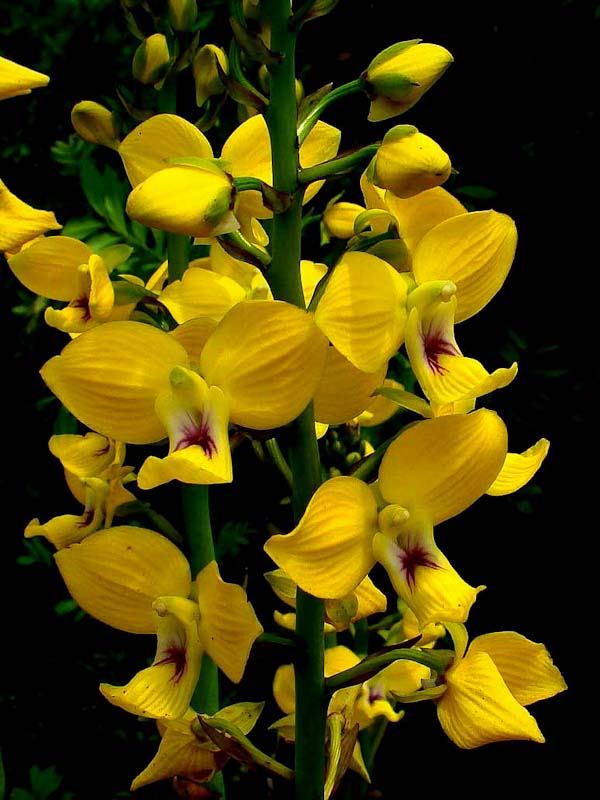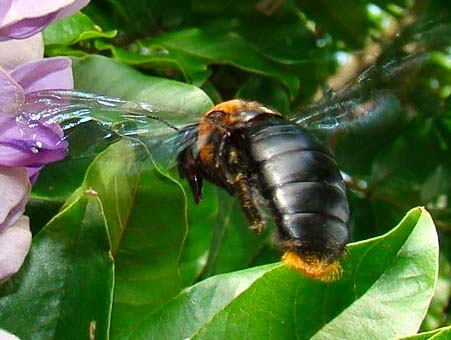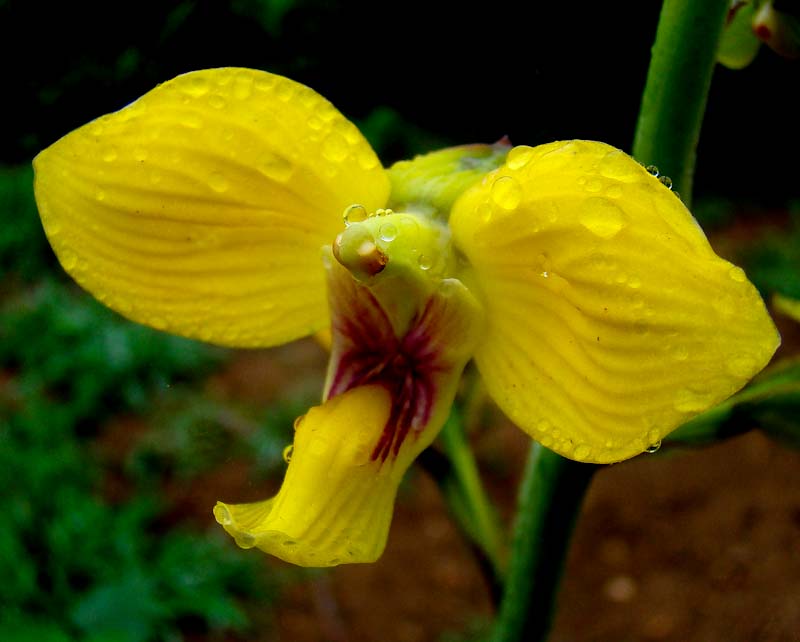Eulophia
speciosa

Flowers of the Yellow Ground Orchid
Eulophia speciosa
The Zulu names
for this orchid are: Umabelejongosi Ompofu; Umlunge Omhlophe
Eulophia speciosa is aptly named ‘speciosa’ – Latin for ‘beautiful, handsome and showy’.
Eulophia speciosa is a terrestrial perennial orchid plant producing 3 - 6 leaves 15 - 65cm long, the numerous yellow flowers are produced on a central flowering stem up to 150cm tall. The stem grows out of an underground string of pseudobulbs which are 4 - 6 long and up to 4cm wide
Distribution
Eulophia speciosa is a species of terrestrial orchid which has a wide distribution range from Western Saudi Arabia, Yemen, Ethiopia, most countries of the central and eastern parts of Africa, from Angola and the Democratic Republic of the Congo, northern Botswana and north eastern Namibia to Swaziland, Mozambique and South Africa where it occurs from the Limpopo, Mpumalanga, southwards to KwaZulu-Natal through the Eastern Cape to the Western Cape as far as the George-Knysna area.
Habitat
The plants normally grow in savannah grassland, bush land and wooded grassland, and have also been recorded from marshy coastal grassland and montane grassland. They are found in grassland from near sea level often exposed to salt spray to 1 700 m in southern Africa, and up to 2 000 m in East Africa. In South Africa the plants usually grow in colonies of up to 50 plants generally in sandy soils but are also found growing in clay soils. This wide-ranging species is obviously rather adaptable, and can therefore thrive under different conditions in cultivation although it is not likely to survive very severe frost.
Ecology
The flowers of this species are deceptive and offer no nectar or other reward to the pollinating insect. Pollinators are large carpenter bees (Xylocopa species.)

Cultural uses
Root infusions of Eulophia speciosa are prepared as emetics for both humans and animals. In traditional medicine, emetics are widely used to facilitate the removal of what is thought to be the cause of the ailment.
Eulophia speciosa plants are also used as a protective charm against storms.
It is reported that Eulophia speciosa bulbs are a favoured food of local people within the plants native range, and are extensively harvested from the wild for local use.
Often eaten raw, sometimes with a little salt, as soon as it is harvested, the bulb is also mashed up and mixed with other raw food plants such as Talinum spp., Dipcadi glaucum and Kedrostis foetidissima. The pounded roots are also added to soups and sauces
Growing Eulophia speciosa
I have grown Eulophia speciosa for about the last 50 years and have found them easy to grow, but be aware that too much care can kill them.
Eulophia speciosa is often a pioneer plant generally found growing on poor sandy soils near the coast.
Over the last few years I have tested Eulophia speciosa for their suitability to be grown as green roof plants with great success, under conditions where they only receive natural rainfall mostly in the summer months. In trials they have proved to be most suitable for growing on extensive green roofs that receive little maintenance and little or no supplemental watering.
Eulophia speciosa are best grown in pots or large growing containers where they are safe from attack by mole rats or planted out in garden beds where they will need to be carefully monitored for attack by mole rats. If mole rats find them then they will probably need to be lifted and put into containers because once found the mole rats will not leave until they have eaten the last bulb. Eulophia speciosa needs to grow in full sun for much of the day to flower well and to remain healthy.

During the growing period, the substrate should be kept fairly moist,
but a
constantly wet soil must be avoided. Plants are best transplanted and
divided in the dormant season. Eulophia speciosa may to some degree be
dependent on mycorrhiza fungus species but it
is certainly not necessary to inoculate the potting medium with
mycorrhiza fungus because the roots of the plants will already have
their populations living within them.
Suitable drainage must be provided to prevent water logging in times of prolonged heavy rain to avoid rotting of the roots. Regular watering should not be needed, only during periods of drought will they need additional watering. An annual topdressing with well rotted leaf mould or bark compost mixed with a little slow release fertiliser and a little lime is essential for healthy sustained growth of the plants. Occasional feeding with a liquid fertilizer during the growing season will do no harm but do not overdo it or the plants will become weak and will be far more susceptible to bacterial rot and fungus attack.
Although Eulophia speciosa has great hybridizing potential I strongly
discourage doing so because of the possible contamination of wild
specimens.I have grown Eulophia speciosa for about the last 50 years and have found them easy to grow, but be aware that too much care can kill them.
Eulophia speciosa is often a pioneer plant generally found growing on poor sandy soils near the coast.
Over the last few years I have tested Eulophia speciosa for their suitability to be grown as green roof plants with great success, under conditions where they only receive natural rainfall mostly in the summer months. In trials they have proved to be most suitable for growing on extensive green roofs that receive little maintenance and little or no supplemental watering.
Eulophia speciosa are best grown in pots or large growing containers where they are safe from attack by mole rats or planted out in garden beds where they will need to be carefully monitored for attack by mole rats. If mole rats find them then they will probably need to be lifted and put into containers because once found the mole rats will not leave until they have eaten the last bulb. Eulophia speciosa needs to grow in full sun for much of the day to flower well and to remain healthy.

Suitable drainage must be provided to prevent water logging in times of prolonged heavy rain to avoid rotting of the roots. Regular watering should not be needed, only during periods of drought will they need additional watering. An annual topdressing with well rotted leaf mould or bark compost mixed with a little slow release fertiliser and a little lime is essential for healthy sustained growth of the plants. Occasional feeding with a liquid fertilizer during the growing season will do no harm but do not overdo it or the plants will become weak and will be far more susceptible to bacterial rot and fungus attack.
Propagation
The simplest way to propagate Eulophia speciosa is by division of dormant back bulbs which are removed leaving three healthy pseudobulbs for continued growth of the mother plant.
To produce large numbers of plants in a short period of time propagation will need to be done by means of planting seed. Practically every flower will produce viable seed pods if hand pollinated regardless if they are self or cross pollinated, but do not overdo or the plants will become weakened by the effort of producing too larger amount of seed, 5 seed pods per plant should be fine.
The seed can be grown in vitro on a suitable growing medium with ease if suitable equipment is at hand, otherwise you can simply do what I have done for years and that is to simply plant the seed in prepared seed beds. I have used this method to grow Eulophia speciosa over many years with a good degree of success. I also find many seedlings that just pop up in the garden from time to time from seed that my plants produce. In cultivation I have found that they mature to flowering size, in between two to three years depending on conditions.
Pests and diseases
A number of pests feed on Eulophia speciosa such as mole rats, leaf miners and the yellow orchid beetle Lema pectoralis which do a large amount of damage to the plants if not dealt with promptly.
In fact grown outdoors the yellow orchid beetle Lema pectoralis can be a major pest which can badly damage or kill a plant in the blink of an eyelid. To control the yellow orchid beetle and leaf miner on my plants growing outside on my roof, at the beginning of the growing season I sprinkle Efekto insecticide granules around the plants
Yellow orchid beetle Lema
pectoralis
Bacterial rot leading to the death of the plant due to over watering, watering during the dormant season, crowding, insufficient air circulation and insufficient direct sun light can be a very serious problem. If planted out in large numbers in garden beds, the plants most probably will eventually be found and be eaten by mole rats that feed on the pseudobulbs. If Mole rats find them then they will have to be lifted to be placed in containers or they will eat every last one.
Green Roof
Eulophia speciosa has all the attributes to be an excellent green roof plant, to confirm this I have tested Eulophia speciosa for over 10 years under the conditions I experience at Mount Moreland with very good results. In fact many new plants have arrived of their own accord from seed blown into other green roof growing trays and pots placed on my roofs.
Feeding
I feed my plants once per week at very low concentrations usually one quarter or less than the recommended application rate with a variety of feeds, being EasyGro™ Flower and Fruit 3:1:6(46) hydroponic feed distributed by Rolfes Agri, Seagro, Nitrosol, fulvic acid as well as with both black as well as rooibos tea. Be very careful overfeeding will most certainly weaken and kill your plants
Landscape uses
Eulophia speciosa is a very showy and desirable plant to include in any landscape design or home garden.
Eulophia speciosa makes a good container plant for the patio and brings colour and life to the green roof be it big or small.
Some of many Eulophia speciosa
plants undergoing suitability trails as
green roof plants at Mount Moreland
General Information
Eulophia speciosa is the floral emblem of the South African Orchid Council https://southafricanorchidcouncil.onuniverse.com/
| Home |
Contact | |
| Green Roof |
Rehabilitation |
|
| Landscaping |
Weed |
|
 |
 |